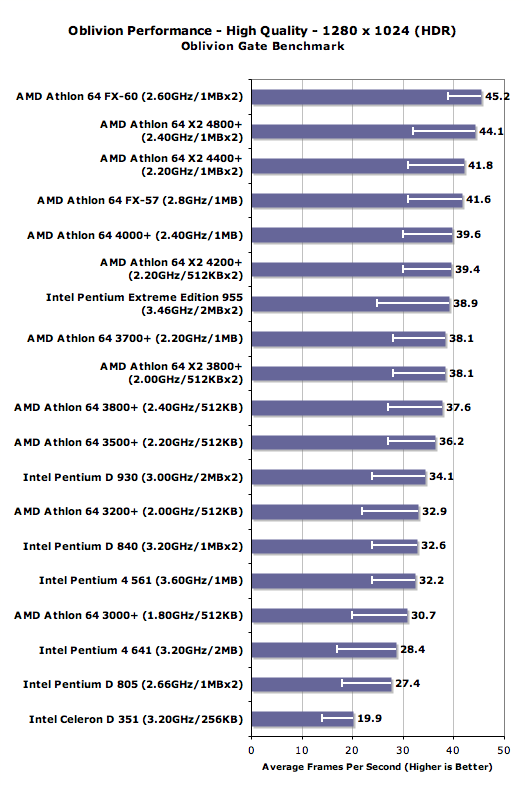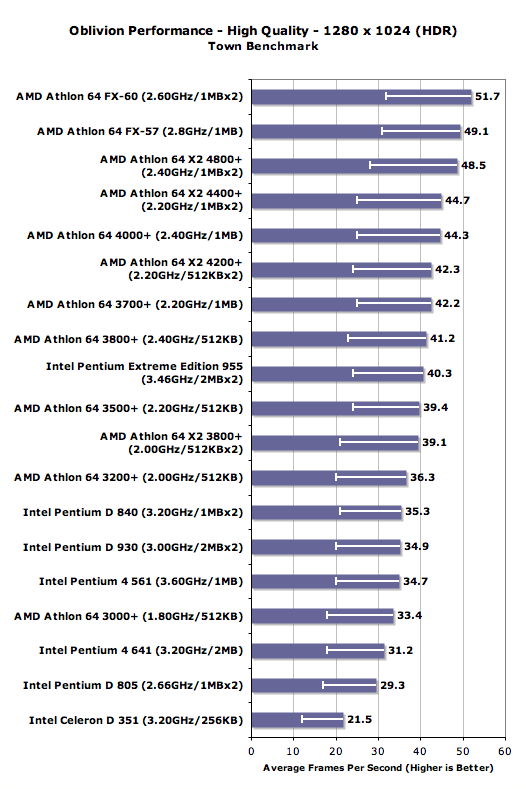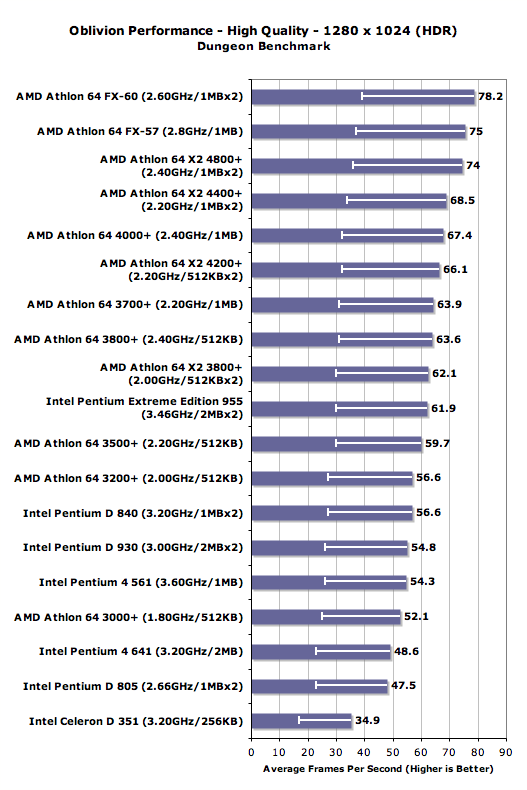The Elder Scrolls IV: Oblivion CPU Performance
by Anand Lal Shimpi on April 28, 2006 10:00 AM EST- Posted in
- CPUs
Oblivion CPU Performance

Here's one thing we really didn't expect, for our most GPU intensive test to be extremely CPU dependent as well. In its natural state with no out-of-game tweaks, Oblivion will give dual-core CPUs about a 10% increase in performance over their single core counterparts at the top of our charts. Moving down the graphs, the X2 3800+ has a 15% performance advantage over the 3200+, while the Pentium 930 has a 20% advantage over a higher clocked Pentium 4 641.
While 10% may not sound like a lot, especially given that our FRAPS benchmarks can vary by up to 5% between runs, keep in mind that this is an extremely GPU intensive benchmark. A 10% difference with the fastest clockspeeds available is pretty significant. Intel clearly has more need of help, and the larger 15-20% boost they get from dual-core processors is nice to see. Unfortunately, it's not nearly enough to catch up to AMD's competing offerings.
As we've seen in other games, AMD's Athlon 64 X2 and vanilla Athlon 64 are the way to go, taking up the overwhelming majority of the top spots in this graph. The Pentium Extreme Edition 955 is about the only Intel CPU that is significantly competitive here; the Pentium D 930 is the next time that Intel makes another appearance and it offers performance lower than the single core Athlon 64 3500+.
Later in this review we will look at another way of characterizing CPU performance in Oblivion, but rest assured that this graph is far more important than just stating for the millionth time that the Athlon 64 FX-60 is faster than the Athlon 64 3500+....

Once again, we see a 10-15% boost from dual core CPUs in our Town benchmark. The rest of the standings and performance echo what we saw in the Oblivion Gate test above. The usefulness of the Radeon X1900 XT CrossFire setup diminishes significantly as you begin to move down the list of contenders; you'll actually lose over 20% of your real world frame rate if you've got an Athlon 64 3500+ vs. if you had an Athlon 64 FX-60. These aren't low resolution tests designed to isolate the impact of your CPU, these are tests at reasonable display settings for the GPU setup and these are real world results.
Oblivion also clearly benefits from larger CPU caches. The abysmal performance of the Celeron D 351 exemplifies this statement, but you can also look at higher performing parts. The difference between the Athlon 64 3700+ and the 3500+ is around 5-7%, which is more than many other titles show.

Our final Oblivion benchmark delivers the same message we've seen in the first two: CPU performance matters. But the real question is, how fast of a CPU do you really need to make your GPU investment worthwhile? That's the question we're answering next...










36 Comments
View All Comments
kmmatney - Saturday, April 29, 2006 - link
If you look at the Tom Hardware charts, plot the performance of the 256K cache Semprons on a chart, and then extrapolate to higher frequencies, a Sempron at 2.45 GHz will perform better than the Athlon 3500+, and closer to the Athlon 3700+. It does start to fall back a little in the heavy multitasking benchmarks, but for gaming and content creation its very close to an Athlon 3700+.For instance, if you take the Far Cry benchmark at 1280 x 1024 (other benchmarks behave the same):
Sempron 256K 1.4 Ghz = 126.9
Sempron 256K 1.6 Ghz = 140.0
Sempron 256K 1.8 Ghz = 151.6
Sempron 256K 2.0 Ghz = 162.7
This forms a linear curve with very little drop-off with speed increase
Now extrapolate to 2.4 GHz
Sempron 256K 2.4 GHz = 186.95 (predicted)
Sempron 256K 2.45 GHz = 189.95 (predicted)
Sempron 256K 2.5 GHz = 192.9
Athlon 3700+ San Diego: 190.9
Athlon 3500+ Venice : 186.2
Athlon 3200+ Venice : 176.5
For a given amount of money, an overclocked Sempron paired with a high end video card will give you the best bang-for-buck for gaming.
JarredWalton - Saturday, April 29, 2006 - link
I'm not talking about as an overall platform; I'm talking specifically about Oblivion performance. Clearly, looking at the 3500+ vs. 3700+, the jump from 512K to 1024K L2 helps quite a bit. Looking at Celeron D, 256K and a lower FSB kills performance. It's not too much of a stretch to guess that Sempron chips will do proportionately worse in Oblivion than in many other games/applications.kmmatney - Saturday, April 29, 2006 - link
Also, the low end S939 Athlon 64s have come down in price, with the cheapest now at $109, so right now, I would agree that Socket 939 is the way to go now, even for a low end system.If you look in the area of the game that counts, the outdoor scenes, the extra 512K of cache gives you an extra 2 fps. An educated guess would put a Sempron 3100+ running at stock speeds at 28.5 fps. Overclocked to 2.4 Ghz it would be around 35 fps. Not great, but very playable.
JarredWalton - Saturday, April 29, 2006 - link
True, you won't notice 2 FPS difference. The thing is, a few people are talking about overclocked Sempron versus stock clock speed Athlon 64. If you're going to overclock one, you have to overclock the other. My experience is that socket 939 overclocks far better than socket 754, the so a lot of those Athlon 64 3000+ chips can hit 2.5 to 2.7 GHz on air cooling.JarredWalton - Saturday, April 29, 2006 - link
Oops -- posted too soon.You might be talking about five to 10 frames per second difference at that point, which would definitely be noticeable. Of course, if you're looking at running a Sempron with the typical PCI express or AGP card, you will likely be GPU limited anyway. Even a GeForce 7600 GT is going to struggle with the outdoor scenes.
Powermoloch - Friday, April 28, 2006 - link
Yeah, I was wondering about that too :). My gaming rig is being powered by 3100 sempron paris and I did overclocked it @ 2.069 Ghz. Oblivion went out pretty fine at most times, and I'm really enjoying the game.